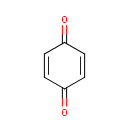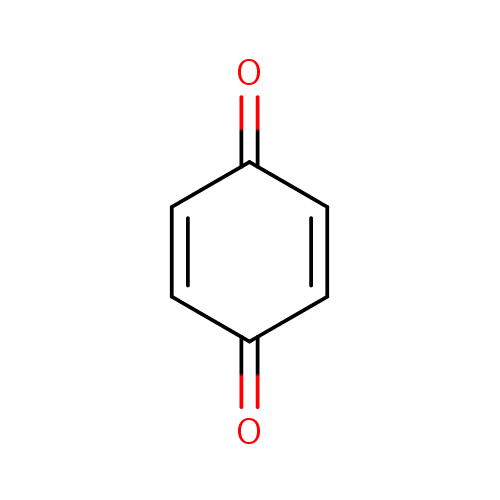|
Record Information |
|---|
| Version |
1.0 |
|---|
| Update Date |
1/22/2018 11:54:54 AM |
|---|
|
Metabolite ID | PAMDB003450 |
|---|
|
Identification |
|---|
| Name: |
Quinone |
|---|
| Description: | Quinone is also called 1,4-benzoquinone or cyclohexadienedione. Quinones are oxidized derivatives of aromatic compounds and are often readily made from reactive aromatic compounds with electron-donating substituents such as phenols and catechols, which increase the nucleophilicity of the ring and contributes to the large redox potential needed to break aromaticity. Derivatives of quinones are common constituents of biologically relevant molecules. Some serve as electron acceptors in electron transport chains such as those in photosynthesis (plastoquinone, phylloquinone), and aerobic respiration (ubiquinone). |
|---|
|
Structure |
|
|---|
| Synonyms: | - 1,2,4-trihydroxybenzene
- 1,4-Benzochinon
- 1,4-Benzoquine
- 1,4-Benzoquinone
- 1,4-Cyclohexadiene dioxide
- 1,4-Cyclohexadienedione
- 1,4-Diossibenzene
- 1,4-Dioxy-benzol
- 1,4-Dioxybenzene
- 2,5-Cyclohexadiene-1,4-dione
- 4-hydroxycatechol
- Benzene-1,2,4-triol
- Benzo-1,4-quinone
- Benzo-chinon
- Benzoquinone
- Benzoquinone [UN2587]
- Chinon
- Chinone
- Cyclohexadiene-1,4-dione
- Cyclohexadienedione
- Eldoquin
- Hydroxyhydroquinone
- Hydroxyquinol
- P-Benzoquinone
- P-Chinon
- P-Quinone
- Para-Benzoquinone
- Para-Quinone
- Quinone1,4-Benzoquinone
- Semiquinone anion
- Semiquinone radicals
|
|---|
|
Chemical Formula: |
C6H4O2 |
|---|
| Average Molecular Weight: |
108.0948 |
|---|
| Monoisotopic Molecular
Weight: |
108.021129372 |
|---|
| InChI Key: |
AZQWKYJCGOJGHM-UHFFFAOYSA-N |
|---|
| InChI: | InChI=1S/C6H4O2/c7-5-1-2-6(8)4-3-5/h1-4H |
|---|
| CAS
number: |
106-51-4 |
|---|
| IUPAC Name: | cyclohexa-2,5-diene-1,4-dione |
|---|
|
Traditional IUPAC Name: |
quinone |
|---|
| SMILES: | O=C1C=CC(=O)C=C1 |
|---|
|
Chemical Taxonomy |
|---|
|
Taxonomy Description | This compound belongs to the class of organic compounds known as p-benzoquinones. These are benzoquinones where the two C=O groups are attached at the 1- and 4-positions, respectively. |
|---|
|
Kingdom |
Organic compounds |
|---|
| Super Class | Organooxygen compounds |
|---|
|
Class |
Carbonyl compounds |
|---|
| Sub Class | Ketones |
|---|
|
Direct Parent |
P-benzoquinones |
|---|
| Alternative Parents |
|
|---|
| Substituents |
- P-benzoquinone
- Hydrocarbon derivative
- Aliphatic homomonocyclic compound
|
|---|
| Molecular Framework |
Aliphatic homomonocyclic compounds |
|---|
| External Descriptors |
|
|---|
|
Physical Properties |
|---|
| State: |
Solid |
|---|
| Charge: | 0 |
|---|
|
Melting point: |
115.7 C |
|---|
| Experimental Properties: |
| Property | Value | Source |
|---|
| Water Solubility: | 11.1 mg/mL at 18 oC [YALKOWSKY,SH & DANNENFELSER,RM (1992)] | PhysProp |
|
|---|
| Predicted Properties |
|
|---|
|
Biological Properties |
|---|
| Cellular Locations: |
Cytoplasm |
|---|
| Reactions: | |
|---|
|
Pathways: |
- Alanine, aspartate and glutamate metabolism pae00250
- Arginine and proline metabolism pae00330
- Benzoate degradation via CoA ligation pae00632
- Butanoate metabolism pae00650
- Citrate cycle (TCA cycle) pae00020
- Glycerophospholipid metabolism pae00564
- Glyoxylate and dicarboxylate metabolism pae00630
- Metabolic pathways pae01100
- Methane metabolism pae00680
- Microbial metabolism in diverse environments pae01120
- Oxidative phosphorylation pae00190
- Pyrimidine metabolism pae00240
- Pyruvate metabolism pae00620
- Reductive carboxylate cycle (CO2 fixation) pae00720
- Two-component system pae02020
- Ubiquinone and other terpenoid-quinone biosynthesis pae00130
|
|---|
|
Spectra |
|---|
| Spectra: |
| Spectrum Type | Description | Splash Key | |
|---|
| GC-MS | GC-MS Spectrum - GC-MS | Not Available |
|---|
| LC-MS/MS | LC-MS/MS Spectrum - Quattro_QQQ 10V, Positive (Annotated) | splash10-0a4i-7900000000-fca2433f986ba378f8c9 | View in MoNA |
|---|
| LC-MS/MS | LC-MS/MS Spectrum - Quattro_QQQ 25V, Positive (Annotated) | splash10-00or-9000000000-6897ef153b4119e50ceb | View in MoNA |
|---|
| LC-MS/MS | LC-MS/MS Spectrum - Quattro_QQQ 40V, Positive (Annotated) | splash10-014u-9000000000-9bddbff45c6d0d3e0cf1 | View in MoNA |
|---|
| LC-MS/MS | LC-MS/MS Spectrum - EI-B (JEOL JMS-D-3000) , Positive | splash10-0zgi-9500000000-c8bfbbc465fad7929f87 | View in MoNA |
|---|
| Predicted LC-MS/MS | Predicted LC-MS/MS Spectrum - 10V, Positive | Not Available |
|---|
| Predicted LC-MS/MS | Predicted LC-MS/MS Spectrum - 20V, Positive | Not Available |
|---|
| Predicted LC-MS/MS | Predicted LC-MS/MS Spectrum - 40V, Positive | Not Available |
|---|
| Predicted LC-MS/MS | Predicted LC-MS/MS Spectrum - 10V, Negative | Not Available |
|---|
| Predicted LC-MS/MS | Predicted LC-MS/MS Spectrum - 20V, Negative | Not Available |
|---|
| Predicted LC-MS/MS | Predicted LC-MS/MS Spectrum - 40V, Negative | Not Available |
|---|
| MS | Mass Spectrum (Electron Ionization) | splash10-0zgi-9200000000-8777cde0dbcbb2157cdd | View in MoNA |
|---|
| 1D NMR | 1H NMR Spectrum | Not Available |
|---|
| 1D NMR | 1H NMR Spectrum | Not Available |
|---|
| 1D NMR | 13C NMR Spectrum | Not Available |
|---|
| 2D NMR | [1H,13C] 2D NMR Spectrum | Not Available |
|---|
|
|---|
|
References |
|---|
| References: |
- Bello RI, Gomez-Diaz C, Navarro F, Alcain FJ, Villalba JM: Expression of NAD(P)H:quinone oxidoreductase 1 in HeLa cells: role of hydrogen peroxide and growth phase. J Biol Chem. 2001 Nov 30;276(48):44379-84. Epub 2001 Sep 20. Pubmed: 11567026
- Fabiani R, De Bartolomeo A, Morozzi G: Involvement of oxygen free radicals in the serum-mediated increase of benzoquinone genotoxicity. Environ Mol Mutagen. 2005 Oct;46(3):156-63. Pubmed: 15920754
- Gaskell M, McLuckie KI, Farmer PB: Comparison of the repair of DNA damage induced by the benzene metabolites hydroquinone and p-benzoquinone: a role for hydroquinone in benzene genotoxicity. Carcinogenesis. 2005 Mar;26(3):673-80. Epub 2004 Dec 23. Pubmed: 15618234
- Hasegawa T, Matsuzaki M, Takeda A, Kikuchi A, Furukawa K, Shibahara S, Itoyama Y: Increased dopamine and its metabolites in SH-SY5Y neuroblastoma cells that express tyrosinase. J Neurochem. 2003 Oct;87(2):470-5. Pubmed: 14511124
- He K, Talaat RE, Woolf TF: Incorporation of an oxygen from water into troglitazone quinone by cytochrome P450 and myeloperoxidase. Drug Metab Dispos. 2004 Apr;32(4):442-6. Pubmed: 15039298
- He K, Woolf TF, Kindt EK, Fielder AE, Talaat RE: Troglitazone quinone formation catalyzed by human and rat CYP3A: an atypical CYP oxidation reaction. Biochem Pharmacol. 2001 Jul 15;62(2):191-8. Pubmed: 11389877
- Kwasnicka-Crawford DA, Vincent SR: Role of a novel dual flavin reductase (NR1) and an associated histidine triad protein (DCS-1) in menadione-induced cytotoxicity. Biochem Biophys Res Commun. 2005 Oct 21;336(2):565-71. Pubmed: 16140270
- Mu D, Medzihradszky KF, Adams GW, Mayer P, Hines WM, Burlingame AL, Smith AJ, Cai D, Klinman JP: Primary structures for a mammalian cellular and serum copper amine oxidase. J Biol Chem. 1994 Apr 1;269(13):9926-32. Pubmed: 8144587
- Park S, Geddes TJ, Javitch JA, Kuhn DM: Dopamine prevents nitration of tyrosine hydroxylase by peroxynitrite and nitrogen dioxide: is nitrotyrosine formation an early step in dopamine neuronal damage? J Biol Chem. 2003 Aug 1;278(31):28736-42. Epub 2003 May 27. Pubmed: 12771134
- Roberg K, Johansson U, Ollinger K: Lysosomal release of cathepsin D precedes relocation of cytochrome c and loss of mitochondrial transmembrane potential during apoptosis induced by oxidative stress. Free Radic Biol Med. 1999 Dec;27(11-12):1228-37. Pubmed: 10641715
- Siegel D, Ryder J, Ross D: NAD(P)H: quinone oxidoreductase 1 expression in human bone marrow endothelial cells. Toxicol Lett. 2001 Dec 15;125(1-3):93-8. Pubmed: 11701227
- Smith MT: The mechanism of benzene-induced leukemia: a hypothesis and speculations on the causes of leukemia. Environ Health Perspect. 1996 Dec;104 Suppl 6:1219-25. Pubmed: 9118896
- Soucek P: Cytochrome P450 destruction by quinones: comparison of effects in rat and human liver microsomes. Chem Biol Interact. 1999 Aug 1;121(3):223-36. Pubmed: 10462055
- Terman A, Neuzil J, Kagedal K, Ollinger K, Brunk UT: Decreased apoptotic response of inclusion-cell disease fibroblasts: a consequence of lysosomal enzyme missorting? Exp Cell Res. 2002 Mar 10;274(1):9-15. Pubmed: 11855852
- Toyota T, Ueno Y: [Clinical effect and side effect of troglitazone] Nippon Rinsho. 2000 Feb;58(2):376-82. Pubmed: 10707561
- Xu L, Eiseman JL, Egorin MJ, D'Argenio DZ: Physiologically-based pharmacokinetics and molecular pharmacodynamics of 17-(allylamino)-17-demethoxygeldanamycin and its active metabolite in tumor-bearing mice. J Pharmacokinet Pharmacodyn. 2003 Jun;30(3):185-219. Pubmed: 14571691
- Yamazaki H, Shibata A, Suzuki M, Nakajima M, Shimada N, Guengerich FP, Yokoi T: Oxidation of troglitazone to a quinone-type metabolite catalyzed by cytochrome P-450 2C8 and P-450 3A4 in human liver microsomes. Drug Metab Dispos. 1999 Nov;27(11):1260-6. Pubmed: 10534310
|
|---|
| Synthesis Reference: |
Harman, Robert E.; Cason, James. The preparation of quinones from p-aminophenols obtained by electrolytic reduction of aromatic nitro compounds. Journal of Organic Chemistry (1952), 17 1058-62. |
|---|
| Material Safety Data Sheet (MSDS) |
Download (PDF) |
|---|
|
Links |
|---|
| External Links: |
|
|---|


